汉英词汇比较与翻译
- 格式:doc
- 大小:83.00 KB
- 文档页数:6
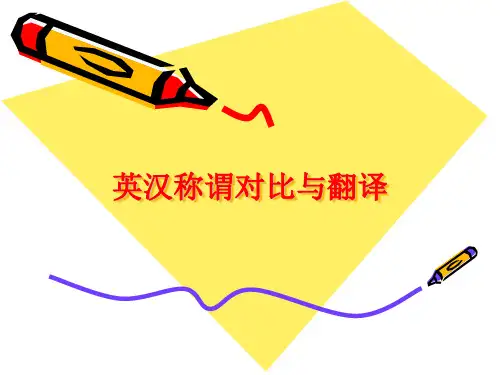
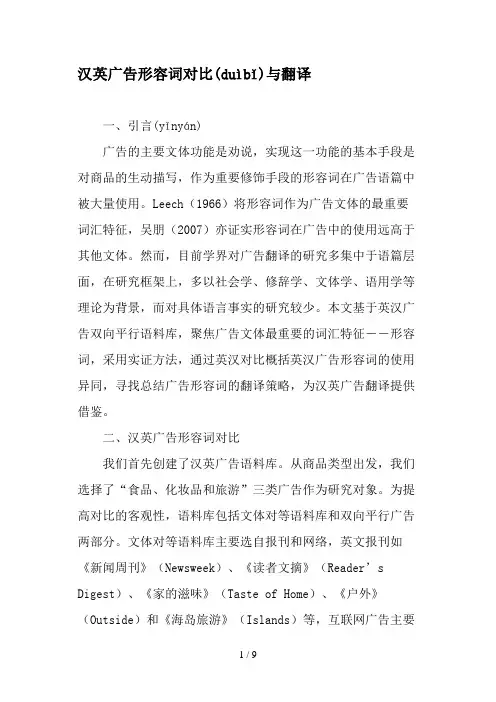
汉英广告形容词对比(duìbǐ)与翻译一、引言(yǐnyán)广告的主要文体功能是劝说,实现这一功能的基本手段是对商品的生动描写,作为重要修饰手段的形容词在广告语篇中被大量使用。
Leech(1966)将形容词作为广告文体的最重要词汇特征,吴朋(2007)亦证实形容词在广告中的使用远高于其他文体。
然而,目前学界对广告翻译的研究多集中于语篇层面,在研究框架上,多以社会学、修辞学、文体学、语用学等理论为背景,而对具体语言事实的研究较少。
本文基于英汉广告双向平行语料库,聚焦广告文体最重要的词汇特征――形容词,采用实证方法,通过英汉对比概括英汉广告形容词的使用异同,寻找总结广告形容词的翻译策略,为汉英广告翻译提供借鉴。
二、汉英广告形容词对比我们首先创建了汉英广告语料库。
从商品类型出发,我们选择了“食品、化妆品和旅游”三类广告作为研究对象。
为提高对比的客观性,语料库包括文体对等语料库和双向平行广告两部分。
文体对等语料库主要选自报刊和网络,英文报刊如《新闻周刊》(Newsweek)、《读者文摘》(Reader’s Digest)、《家的滋味》(Taste of Home)、《户外》(Outside)和《海岛旅游》(Islands)等,互联网广告主要来源于Yahoo。
双向平行语料库来自出口商品和进口商品的商标和机场、景点等处的宣传手册。
通过语料库检索,我们发现汉英广告形容词具有(jùyǒu)两点共性特征。
第一,汉英广告都大量使用褒义形容词,特别是褒义形容词的比较级和最高级来显化商品价值,以此突出产品优点和树立积极形象,如例(1)、例(2)。
“new,good,better,nice,fresh,rich,great,delicious”等词在英语广告中使用频繁。
同样(tóngyàng),汉语广告也偏爱用“新,好,顶,美”等形容词。
(1)a.Better choice,better living――Vitasoyb.维他奶,更好选择(xuǎnzé),更好生活――维他奶(2)凝聚新动力,文康展新姿――康乐(kānglè)及文化事务署第二,汉英广告都有大量由其他词类派生的或者新拟的形容词,如例(3)、例(4)。
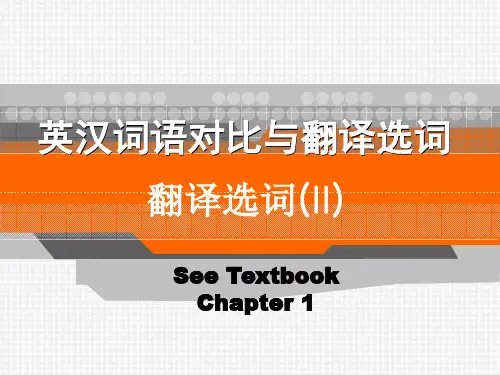
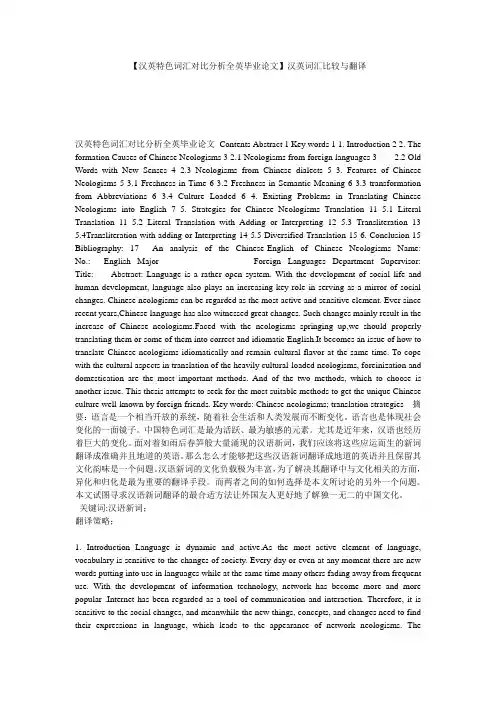
【汉英特色词汇对比分析全英毕业论文】汉英词汇比较与翻译汉英特色词汇对比分析全英毕业论文Contents Abstract 1 Key words 1 1. Introduction 2 2. The formation Causes of Chinese Neologisms 3 2.1 Neologisms from foreign languages 3 2.2 Old Words with New Senses 4 2.3 Neologisms from Chinese dialects 5 3. Features of Chinese Neologisms 5 3.1 Freshness in Time 6 3.2 Freshness in Semantic Meaning 6 3.3 transformation from Abbreviations 6 3.4 Culture Loaded 6 4. Existing Problems in Translating Chinese Neologisms into English 7 5. Strategies for Chinese Neologisms Translation 11 5.1 Literal Translation 11 5.2 Literal Translation with Adding or Interpreting 12 5.3 Transliteration 13 5.4Transliteration with adding or Interpreting 14 5.5 Diversified Translation 15 6. Conclusion 15 Bibliography: 17 An analysis of the Chinese-English of Chinese Neologisms Name: No.: English Major Foreign Languages Department Supervisor: Title: Abstract: Language is a rather open system. With the development of social life and human development, language also plays an increasing key role in serving as a mirror of social changes. Chinese neologisms can be regarded as the most active and sensitive element. Ever since recent years,Chinese language has also witnessed great changes. Such changes mainly result in the increase of Chinese neologisms.Faced with the neologisms springing up,we should properly translating them or some of them into correct and idiomatic English.It becomes an issue of how to translate Chinese neologisms idiomatically and remain cultural flavor at the same time. To cope with the cultural aspects in translation of the heavily cultural-loaded neologisms, foreinization and domestication are the most important methods. And of the two methods, which to choose is another issue. This thesis attempts to seek for the most suitable methods to get the unique Chinese culture well-known by foreign friends. Key words: Chinese neologisms; translation strategies 摘要:语言是一个相当开放的系统,随着社会生活和人类发展而不断变化。
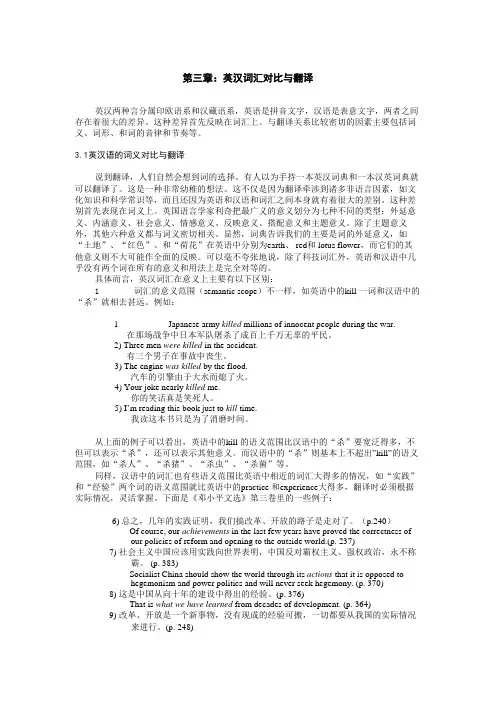
第三章:英汉词汇对比与翻译英汉两种言分属印欧语系和汉藏语系,英语是拼音文字,汉语是表意文字,两者之间存在着很大的差异。
这种差异首先反映在词汇上。
与翻译关系比较密切的因素主要包括词义、词形、和词的音律和节奏等。
3.1英汉语的词义对比与翻译说到翻译,人们自然会想到词的选择。
有人以为手持一本英汉词典和一本汉英词典就可以翻译了。
这是一种非常幼稚的想法。
这不仅是因为翻译牵涉到诸多非语言因素,如文化知识和科学常识等,而且还因为英语和汉语和词汇之间本身就有着很大的差别。
这种差别首先表现在词义上。
英国语言学家利奇把最广义的意义划分为七种不同的类型:外延意义、内涵意义、社会意义、情感意义、反映意义、搭配意义和主题意义。
除了主题意义外,其他六种意义都与词义密切相关。
显然,词典告诉我们的主要是词的外延意义,如“土地”、“红色”、和“荷花”在英语中分别为earth、 red和 lotus flower,而它们的其他意义则不大可能作全面的反映。
可以毫不夸张地说,除了科技词汇外,英语和汉语中几乎没有两个词在所有的意义和用法上是完全对等的。
具体而言,英汉词汇在意义上主要有以下区别:1 词汇的意义范围(semantic scope)不一样,如英语中的kill 一词和汉语中的“杀”就相去甚远。
例如:1 Japanesekilled millions of innocent people during the war.army在那场战争中日本军队屠杀了成百上千万无辜的平民。
2) Three men were killed in the accident.有三个男子在事故中丧生。
3) The engine was killed by the flood.汽车的引擎由于大水而熄了火。
4) Your joke nearly killed me.你的笑话真是笑死人。
5) I’m reading this book just to kill time.我读这本书只是为了消磨时间。
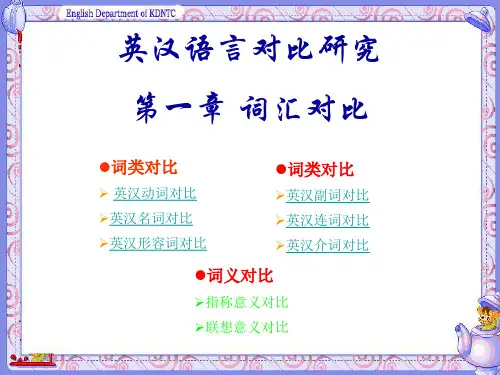

英汉语言词汇对比1. 概述对比两种语言,我们可以从语音、词汇、语法、语用及篇章等各个方面进行比较,但是词汇在这之中似乎更具关键性,因为“语音只是词汇的包装或外衣,而任何语法问题到底就是词的用法问题。
”词算是一门语言比较基础的组成部分,本文主要从两种语言的词汇的形态结构和意义的某几个方面的不同之处来分析一下英汉语中词汇的不同。
2.英汉词汇系统特征对比2.1汉语1)汉字具有独特的方形结构,是一个非字母化书写符号系统。
象形- 表意-拼音是人类语言文字发展的三个层次,汉语长期停滞在表意阶段,有其本身的、特有的译音特征,是表意兼表音的文字。
(ideophonograph)2)汉语文字系统语音承载能力不够完备,音位结构(元音与辅音的组合)不可能明示。
3)汉字音与义的结合的视觉分辨率很高,同音异义字可由视觉分辨,如发音为“jing”的“井”、“颈”、“景”、“警”一看即知,不会混同。
即所谓“因形见义”。
4)音义视觉分辨率高导致词义分辨率很高,如“陈迹”与“沉寂”同音,但不会混淆。
5)汉字不具备形态发生学机制,因为汉字不是可以发生形态变化的拼音文字,而是方块字。
汉字只能附加与粘合,也就是“简单对接”。
6)汉字与语素基本上是一对一的关系,即“字”就是“语素”,许多语素本身即词;词是语素(“字”)的附加或粘着。
能独立的语素(自由语素)结合叫附加,如“好看”;不能独立的语素(粘着语素)结合叫粘着,如“人民”。
2.2英语1)英语文字属于字母化语言书写符号系统,具有较强的可拼读性(按文字符号拼音),可识读性(即词性分辨率);可习性(即按可识读性来识字);可衍生性(即按原型派生、类比的属性)。
2)英语文字系统语音承载能力相对较强,符号表音功能较强。
3)英语词的音义视觉分辨率不高,如well在孤立情况下分不清楚是“好”还是“井”。
英语不能在词一级因形见义。
其主要的、基本的功能是表音。
4)视觉分辨率地导致词义分辨率低。
如在孤立状态下permit(vt. 允许)与permit(n. 许可、许可证)很可能混淆。

汉英对比与翻译正确确立单句的主干:直接用原文的主语1) 如果不适当地处理,锅炉及机动车辆排出的废气就会造成城市空气污染。
________________________________________________________________, causes air pollution in cities.2) 如果说,词汇是语言的“建筑材料”,那么,句子便是文章的“基本部件”。
___________________________________________________, sen tences are the “fundamental parts” of writings.替换主语以符合英语表达1) 鲁迅的骨头是最硬的,他没有丝毫的奴颜和媚骨,这是殖民地半殖民地人民最可宝贵的性格。
Lu Hsun’s bones were the hardest; he was free from all sycophancy or obsequiousness; this is invaluable among colonial and semi-colonial people._________________________________________, free from all sycophancy or obsequiousness; this quality is invaluable among colonial and semi-colonial people.2) 胎又瘪了。
The tire turns flat again?_______________________________________________.3) 人不可貌相,海水不可斗量。
______________________________________, just as we can’t measure the ocean by pints.______________________________________, and impossible to measure the ocean by pints.找出译文中合适的主语1) 在历史上,由于长江不断改道,在武汉地区形成了众多的湖泊。
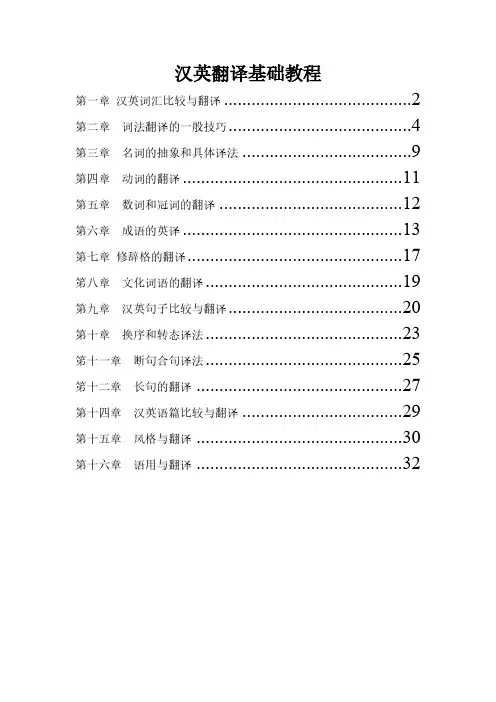
汉英翻译基础教程第一章汉英词汇比较与翻译 (2)第二章词法翻译的一般技巧 (4)第三章名词的抽象和具体译法 (9)第四章动词的翻译 (11)第五章数词和冠词的翻译 (12)第六章成语的英译 (13)第七章修辞格的翻译 (17)笫八章文化词语的翻译 (19)第九章汉英句子比较与翻译 (20)第十章换序和转态译法 (23)笫十一章断句合句译法 (25)笫十二章长句的翻译 (27)第十四章汉英语篇比较与翻译 (29)第十五章风格与翻译 (30)第十六章语用与翻译 (32)第一章汉英词汇比较与翻译第一节翻译中的选义一、结合语境选择较贴切的译文1. b2. a3. b4. a二、译出下列词语,注意词语的不同搭配1. a swarm of beesa brood of chickensa litter of pups2. a bevy of beautiful ladiesa pack of houndsa team of ducksa herd of antelopes3. unfailing supportproactive fiscal policymake effective use of overseas resources4. make a phone calltake a taxiknit a woolen sweaterfetch waterplay basketballspray insecticide5. basic wagecapital constructionessential commodityprimary industryfundamental interest三、翻译下列句子,注意画线词语的理解1. The two leaders exchanged views on bilateral relations and issues of common concern2. Party members should listen carefully to the opinions of the general public.3. They offered some suggestions for the revision of the plan.4. Everyone complained against such a practice.5. They had a dispute at the meeting.6. You should follow the doctor's advice.7. They reached a consensus on this issue.8. There is still some unfinished business to settle.9. We have consulted him about the matter.10. Please go back. There is nothing of your concern now第二节翻译中的选词一、翻译下列各句,注意词的选择和搭配。
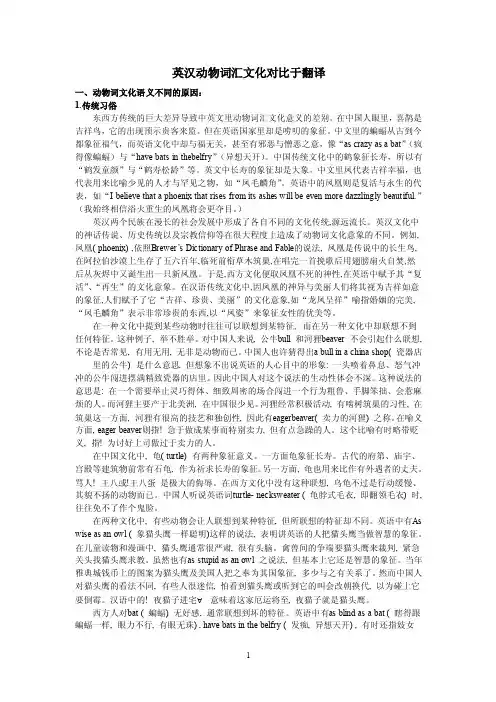
英汉动物词汇文化对比于翻译一、动物词文化语义不同的原因:1.传统习俗东西方传统的巨大差异导致中英文里动物词汇文化意义的差别。
在中国人眼里,喜鹊是吉祥鸟,它的出现预示贵客来监。
但在英语国家里却是唠叨的象征。
中文里的蝙蝠从古到今都象征福气,而英语文化中却与福无关,甚至有邪恶与憎恶之意,像“as crazy as a bat”(疯得像蝙蝠)与“have bats in thebelfry”(异想天开)。
中国传统文化中的鹤象征长寿,所以有“鹤发童颜”与“鹤寿松龄”等。
英文中长寿的象征却是大象。
中文里凤代表吉祥幸福,也代表用来比喻少见的人才与罕见之物,如“凤毛麟角”。
英语中的凤凰则是复活与永生的代表,如“I believe that a phoenix that rises from its ashes will be even more dazzlingly beautiful.”(我始终相信浴火重生的凤凰将会更夺目。
)英汉两个民族在漫长的社会发展中形成了各自不同的文化传统,源远流长。
英汉文化中的神话传说、历史传统以及宗教信仰等在很大程度上造成了动物词文化意象的不同。
例如,凤凰( phoenix) ,依照Br ewer’s Dictionary of Phrase and Fable的说法, 凤凰是传说中的长生鸟,在阿拉伯沙漠上生存了五六百年,临死前衔草木筑巢,在唱完一首挽歌后用翅膀扇火自焚,然后从灰烬中又诞生出一只新凤凰。
于是,西方文化便取凤凰不死的神性,在英语中赋予其“复活”、“再生”的文化意象。
在汉语传统文化中,因凤凰的神异与美丽人们将其视为吉祥如意的象征,人们赋予了它“吉祥、珍贵、美丽”的文化意象,如“龙凤呈祥”喻指婚姻的完美,“凤毛麟角”表示非常珍贵的东西,以“凤姿”来象征女性的优美等。
在一种文化中提到某些动物时往往可以联想到某特征, 而在另一种文化中却联想不到任何特征。
这种例子, 举不胜举。
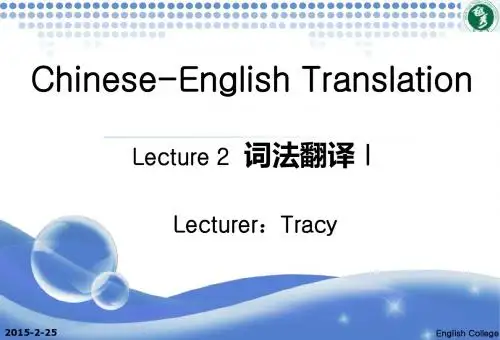
汉英翻译基础教程第一章汉英词汇比较与翻译第一节翻译中的选义一、结合语境选择较贴切的译文1. b2. a3. b4. a二、译出下列词语,注意词语的不同搭配1. a swarm of beesa brood of chickensa litter of pups2. a bevy of beautiful ladiesa pack of houndsa team of ducksa herd of antelopes3. unfailing supportproactive fiscal policymake effective use of overseas resources4. make a phone calltake a taxiknit a woolen sweaterfetch waterplay basketballspray insecticide5. basic wagecapital constructionessential commodityprimary industryfundamental interest三、翻译下列句子,注意画线词语的理解1. The two leaders exchanged views on bilateral relations and issues of common concern2. Party members should listen carefully to the opinions of the general public.3. They offered some suggestions for the revision of the plan.4. Everyone complained against such a practice.5. They had a dispute at the meeting.6. You should follow the doctor's advice.7. They reached a consensus on this issue.8. There is still some unfinished business to settle.9. We have consulted him about the matter.10. Please go back. There is nothing of your concern now第二节翻译中的选词一、翻译下列各句,注意词的选择和搭配。
第三章名词的抽象和具体译法第一节名词的抽象译法(p68)粗枝大叶to be crude and careless (with big branches and large leaves)海阔天空to talk with random( with a vast sea and boundless sky)灯红酒绿dissipated and luxurious (with red lights and green wine)纸醉金迷of life of luxury and dissipation (with drunken paper and bewitched gold)单枪匹马to be single-handed in doing sth (with a solitary spear and a single horse)赤胆忠心ardent loyalty (with red gut and heart)无孔不入to take advantage of every weakness (to get into every hole)扬眉吐气to feel proud and elated (to raise the eyebrows and let out a breath)开门见山to come straight to the point (to open the door and see the mountain)大张旗鼓on a large and spectacular scale (to make a great array of flags and drums)风雨飘摇(of a situation) being unstable (the wind and rain are rocking)二.翻译下列句子(1)这是他们夫妻之间的事情,你去插一脚干吗?That’s a business of their own, between husband and wife. Why should you get involved in? (2)别人家里鸡零狗碎的事情你都知道得这么全,真是个顺风耳啊!You know all the bits and pieces of trifles of other families. You are really well informed. (3)这消息让我出了一身冷汗。
第一章汉英词汇比较与翻译第一节翻译中的选义翻译包括理解和表达两个过程。
要做好翻译,首先要对原文进行正确的理解。
但汉语和英语中都有很普遍的一词多义现象,却给理解和表达都带来了很大的困难。
一.根据词典释义选择合适的词义(略)二.根据语境选择合适的词义语义与语境关系密切。
同样的一个词,在不同的上下文里,就可能产生不同的意思。
英国语言学家Firth曾经说过:Each word is a new word in a new context (每个词在一个新的语境中就是一个新词)。
所以说,“多义词数量很多,但我们在语言的实际运用中,除少数歧义句外,却极少见到词的多义现象。
因为在一个具体语境中只使用多义词的其中一个义项”(傅敬民等,《英汉翻译辨析》,p10)。
先看英译汉的例子。
比如man这个词的翻译:man and wife 夫妻officers and men 官兵his man Friday 佣人,仆人man-of-war 战舰,军舰(尤指帆船)Be a man! 像个男子汉!(勇敢一些,坚强一些)另以straight为例:1. He is a straight thinker.2. Put your room straight.3. She keeps straight.4. The accounts are straight.5. They voted the straight ticket.6. She went straight home without going to the market.7. He was tall and straight and clear-eyed and dark.8. He is fairly straight with me.9. This is a very straight place.10.There are a lot of things we’ve got to get straight.11. Thanks for setting me straight.12. I believe I am thinking straight.13. He keeps a straight face.1.他的思路很有条理。
2.把你的房间整理好。
3.她品行端正。
4.账目清楚。
5.他们投清一色票。
6.她直接回家,没有到市场去。
7.他个子高高,身材挺直,两眼明亮,皮肤黝黑。
8.他对我十分坦率。
9.这可是个十分正经的地方。
10. 有很多事情我们需要搞清楚。
11.谢谢你使我明白过来。
12.我相信我的思路是清晰的。
13.他板着脸(他绷着脸;他面不改色;他面无表情)。
同样,在汉译英时,也需要联系上下文选择符合原文语境的语义。
如“得失”一词的翻译:1.两种办法各有得失。
2.他从不计较个人得失。
1.Each of the two methods has its advantages and disadvantages.2.He never gives thought to personal gain and loss.又如“意见”一词的翻译:1.干部应该虚心听取群众的意见。
2.你应该听从医生的意见。
3.汤姆对此很有意见。
4.许多人对这种做法很有意见。
5.我对该教学计划提出了一些修改意见。
6.双方在昨天的会上闹起了意见。
7.中美两国就双边关系及共同关心的问题交换了意见。
8.双方取得了一致意见。
9.他们在这件事上意见不一。
10.全班就推举谁做班长取得了一致的意见。
11.如果没有意见,现在散会。
1. A cadre should listen modestly to the opinions of the masses.2.You should follow the doctor’s advice.3.Tom has a lot of complaints about it.4.Many people took vigorous (有力的,猛烈的) exception(反对,批评,异议)to such behavior.5.I made some suggestions for the revision of the teaching plan.6.Both sides got into disputes at the meeting yesterday.7.China and the United States exchanged views on bilateral relations andissues of common concern.8.Both sides reached an agreement.9.They have a disagreement with this.10.The whole class has reached unanimity(一致同意)on who will be themonitor.11.If there is no objection, the meeting is over.从以上译例可以看出,一词多义的现象很普遍,即使是一个简单的词也要把它放在原文的语境中去理解。
否则很容易造成理解不到位、译文走样的现象。
原文中的一些常见词,看似容易,在实际操作过程中,却往往译错,究其原因是没有把词语放在特定的语境中去考察,孤立的词语的意义必然是游离不定的。
三.根据搭配选择合适的词义搭配指的是语言系统内各个语言成分的同现和组合,是语言环境的重要组成部分。
一个词与不同的词搭配,便具有不同的含义,我们往往可以根据词的搭配确定词义。
正如Firth所说,You shall know a word by the company it keeps。
他所说的company就是与某一词语同现的搭配词语。
语言与其所处的语言环境中其他语言成分的搭配关系能帮助我们辨析多义词的义项,因为处在特定搭配关系中的多义词,其义项往往会变得单一化、明朗化。
如“正式”一词,与不同的词搭配会有不同的含义。
“正式会议”中的“正式”,指“合乎一般公认的标准的”,译为formal meeting; “正式声明”中的“正式”,指“官方的,有权威性的”,译为official statement; 代表团中的“正式成员”应译为the full member of the delegation。
要想译出用词地道、搭配得当的译文绝非一日之功,需要处处留心,日积月累。
例:身体好,学习好,工作好。
Keep fit, study hard and work hard.例:化1.经济法制化manage economic affairs within a framework2.经济全球化economic globalization3.社会知识化build a knowledge-driven society4.国际关系民主化the practice of democracy in international relations5.国民经济信息化build an information-based national economy6.科研成果产业化apply scientific research results to industrial production例:看1.老师看出了我的心事。
2.这双鞋要是还看得过去,你就买吧。
3.我看出了他的软肋。
4.明天是否出去玩,还得看天气。
5.他看出了苗头。
6.宝贝,别跑得这么快,看摔着!1.The teacher read my thoughts.2.If you think the pair of shoes is all right, then buy it.3.I spotted his weak point.4.Whether we’ll go on a trip tomorrow will depend on the weather.5.He smelt a rat.6.Dear, don’t run so fast. Mind you don’t fall!四.跳出字面,选择合乎逻辑的词义英汉语中都存在一些光看字面无法理解的词语,或是“似是而非”的词语,在翻译过程中尤其要小心这样的“假朋友”(false friend),一旦碰到,就要跳出在翻译时需要尊重这样的约定俗成。
在不同语言中,有些词语所引发的联想是不同的,所以英汉语中有很多动物的比喻不同,如:胆小如鼠as timid as a rabbit落汤鸡 a drowned rat养虎为患to cherish a snake in one’s bosom瓮中捉鳖like a rat in the hole如鱼得水like a duck to water像热锅上的蚂蚁like a hen on a hot girdle (薄煤层)愚蠢如猪as stupid as a goose犟得像头牛as stubborn as a donkey/a mule小结:翻译中的选义是一个老话题,但也是一个常新的话题。
选择合适的词义对于理解原文至关重要,虽然我们可以借助于辞典等工具,找到某个不熟悉的词语的基本意义,但是因为词语随着其搭配、上下文等的不同,而会发生意义上的不同,所以有必要了解词语的引申意义、搭配意义等,甚至要跳出字面,方能选择合乎情理、合乎逻辑的正确释义。
第二章词法翻译的一般技巧第一节对等译法词语是最小的翻译单位。
在翻译过程中,我们往往可以在译文语言中找到和原文某个单词、词组或成语意义相同的词语来表达,这就是我们所说的对等译法。
对等译法是最基本、最常用的翻译技巧。
但不管是在实用类翻译还是在文学翻译实践中,对等译法都不是生搬字(词)典释义,不是死译,不是机械地字字对译。
一.“假朋友”问题在谈到对等的时候,首先需要识别“假朋友”(false friend)问题。
“假朋友”,即“看似相同,实则有别”的假词义相符的词语。
翻译过程中很多误译的现象往往由这些“假朋友”所导致。
主要有以下5种类型的“假朋友”:2. 只对应字面意义而忽略指称意义(strict and literal meaning)差别的“假朋友”,例见表2-2:例:你们偶然看见一棵花生瑟缩地长在地上,不能立刻辨出它有没有果实,非得等到你接触它才能知道。
[译文1] When you come upon(偶遇)a peanut plant lying curled up (卷,弯曲) on the ground, you can never immediately tell whether or not it bears any nuts until you touch them.[译文2] When you come upon a peanut plant lying curled up on the ground, you can never tell whether or not it bears any nuts until you dig it up.。